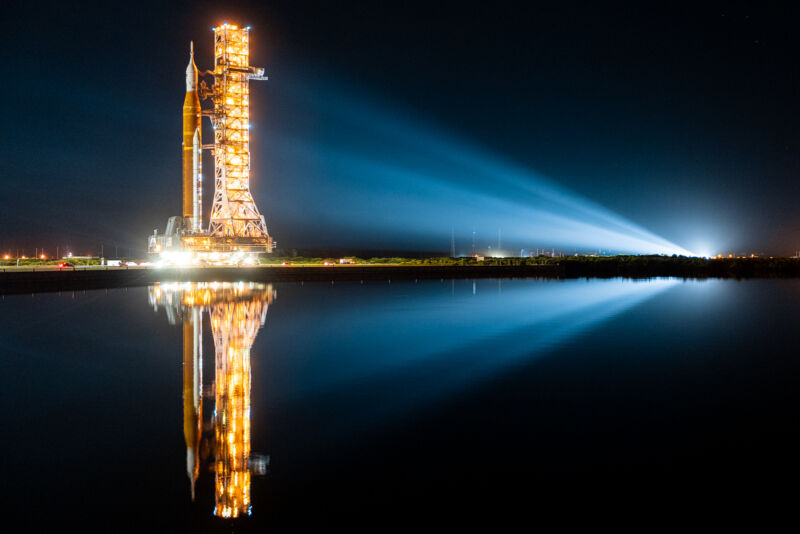As subtropical storm Nicole moved across the Atlantic Ocean toward Florida on Monday afternoon, NASA confirmed that its Artemis I mission would remain at the launch pad along the state's east coast.
"Based on current forecast data, managers have determined the Space Launch System rocket and Orion will remain at Launch Pad 39B," the agency said.
The risks to these large and costly vehicles are non-zero, however, and appear to be rising as Nicole starts to strengthen. The space agency's primary concern from tropical systems is winds. Much of the rocket's structure is pretty robust, such as its tank-like solid rocket boosters. But there are sensitive elements prone to damage from debris and wearing effects due to high winds inside a tropical system.
According to the SLS rocket's chief engineer, John Blevins, the rocket can withstand wind gusts up to 74.1 knots. Knots are a term used in meteorology and maritime navigation and are equal to 1 nautical mile per hour. In this case, the SLS rocket can withstand gusts up to 85 mph, or 137 km/h. Wind "gusts" are different from sustained winds. These are short-term bursts of wind, as opposed to sustained winds over one minute or longer.
Inside for Ian
In September, as Hurricane Ian approached Florida from the other side of the state, NASA made the decision to roll back its Artemis I mission—which includes the rocket, the Orion spacecraft stacked on top, and the mobile launch tower—inside the Vehicle Assembly Building at 10 am ET on September 26. At the time, according to the National Hurricane Center, there was just a 6 percent chance of hurricane-force sustained winds (64 knots or greater) at Kennedy Space Center. Such sustained winds would assuredly have included higher gusts, above the limit Blevins set.
On Monday, at the time NASA announced its decision to remain at the launch pad as Nicole approached Florida, there was just a 4 percent chance of such winds at Kennedy Space Center. NASA, therefore, was willing to take a calculated risk by staying at the pad. One reason for remaining outside was, somewhat ironically, wear and tear.
The process of rolling the Artemis I mission four miles back and forth, between the Vehicle Assembly Building and launch pad, puts a lot of stress on the vehicle. When it computes risk factors for the Artemis I launch vehicle, NASA has a certain budget for rollouts. The rocket has now been out to the pad on four separate occasions since this spring. While NASA has not confirmed this, according to a source, NASA has just one remaining roll in its budget. This does not mean the rocket will fall apart with additional roundtrips, it's just that additional movements would incrementally increase the risk of damage.
NASA may also simply not have had time to move inside the protective confines of the Vehicle Assembly Building. It takes a couple of days to prep the rocket to roll back. By Monday, it may have already been too late because to roll back before Nicole's arrival would probably have meant doing so no later than Tuesday night. Asked whether NASA really had no choice but to remain at the pad, a spokesperson for the agency, Rachel Kraft, was non-committal. "The team reviewed the forecast and determined the rocket will remain at the pad," she said on Monday.
Outside for Nicole
The problem for NASA is that the forecast for Nicole is getting a little worse. As of early Tuesday morning, the National Hurricane Center forecast that Nicole would transition from a subtropical into a tropical storm and come ashore on the Florida coast just south of Kennedy Space Center as a Category 1 hurricane. The corresponding odds for hurricane-force winds—at or above the safety limit established by NASA for its rocket—are now up to 10 percent. This is higher than the forecast that prompted a rollback during Ian.
There remains a relatively low chance of the storm posing a risk to the rocket, but there are nonetheless some reasons for concern. NASA has no hardware at the ready to replace the rocket and spacecraft, which, combined, are valued at $4.1 billion. This mission was originally supposed to launch in 2017, so further delays would only add embarrassment for the space agency and for calls for it to pivot toward the use of more efficient, far less costly private launch vehicles.
There is also the problem that winds increase with height inside a tropical system. The wind-speed probability forecast by the National Hurricane Center shows winds at the surface. Blevins said the 74.1-knot forecast is for the 60-foot level. But the rocket stands much taller than this. The mobile launcher deck, which supports the SLS rocket, is 47 feet above the ground. The rocket and Orion spacecraft stand 322 feet tall, so the top of the stack is 369 feet above the ground.



3175x175(CURRENT).thumb.jpg.b05acc060982b36f5891ba728e6d953c.jpg)
Recommended Comments
There are no comments to display.
Join the conversation
You can post now and register later. If you have an account, sign in now to post with your account.
Note: Your post will require moderator approval before it will be visible.